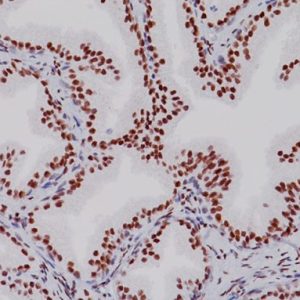Description
Reactive and regenerative squamous epithelium can show a spectrum of histologic alterations that mimic dysplastic and pre-neoplastic cytological and architectural changes. A monoclonal antibody cocktail targeted against mini-chromosome maintenance protein 2 (MCM2) and DNA topoisomerase IIA (TOP2A), when up regulated, serves as a marker of aberrant S-phase induction in proliferating cells (1). MCM2 functions during DNA replication by loading the pre-replication complex onto DNA and unwinding the DNA through helicase activity to permit DNA synthesis. MCM2 is essential for eukaryotic DNA replication and drives the formation of prereplicative complexes, which is the key first step during G1 phase (2). Therefore, altered MCM2 expression may be a hallmark of cell-cycle deregulation, which could be the most essential mechanism in the development and progression of human cancers (2). This protein is overexpressed in cervical dysplasia as a result of HPV infection and subsequent uncontrolled activation of gene transcription and aberrant S-phase induction, which is mediated through the E2F transcription factor pathway. The overexpression of MCM2 provides the link between oncogenic HPV infection and the molecular event of cervical dysplasia (3,4). It has been shown that over-expression of MCM2 in cervical high grade dysplasia can be detected by immunohistochemistry (2). TOP2A is a nucleic enzyme that affects the topological structure of DNA by interacting with the double-helix DNA, thus playing an important role in DNA replication, transcription, recombination, condensation, and segregation (5,6). A monoclonal antibody cocktail directed against MCM2 and TOP2A is a novel immunostaining marker that has been tested in liquid-based cervical cytologic smears and cervical biopsy specimens as a potential diagnostic adjunct for the detection of high grade intraepithelial neoplasia and low grade intraepithelial neoplasia (7,8).
DATASHEETS & SDS
REFERENCES
1. Walts AE, Bose S. p16, Ki-67, and BD ProEx™C immunostaining: a practical approach for diagnosis of cervical intraepithelial neoplasia. Hum Pathol. 2009;40:957.
2. Shi J, et al. Evaluation of p16INK4a, minichromosome maintenance protein 2, DNA topoisomerase IIA, ProEX C, and p16INK4a/ProEX C in cervical squamous intraepithelial lesions. Hum Pathol. 2007;38:1335.
3. Malinowski, DP. Molecular diagnostic assays for cervical neoplasia: emerging markers for the detection of high-grade cervical disease. Biotechniques. 2005;(Suppl 4):17.
4. Ishimi Y, et al. Enhanced expression of Mcm proteins in cancer cells derived from uterine cervix. Eur J Biochem. 2003;270:1089.
5. Wang JC. Cellular roles of DNA topoisomerases: a molecular perspective. Nat Rev Mol Cell Biol. 2002;3:430.
6. Gibbons D, et al. Comparison of topoisomerase II alpha and MIB-1 expression in uterine cervical squamous lesions. Mod Pathol. 1997;10:409.
7. Kelly D, et al. Detection of cervical high-grade squamous intraepithelial lesions from cytologic samples using a novel immunocytochemical assay (ProEx™C). Cancer. 2006;108:494.
8. Shroyer KR, et al. Validation of a novel immunocytochemical assay for topoisomerase II-a and minichromosome maintenance protein 2 expression in cervical cytology. Cancer. 2006;108:324.
9. Center for Disease Control Manual. Guide: Safety Management, NO. CDC-22, Atlanta, GA. April 30, 1976 “Decontamination of Laboratory Sink Drains to Remove Azide Salts.”
10. Clinical and Laboratory Standards Institute (CLSI). Protection of Laboratory Workers from Occupationally Acquired Infections; Approved Guideline-Fourth Edition CLSI document M29-A4 Wayne, PA 2014.







Reviews
There are no reviews yet.